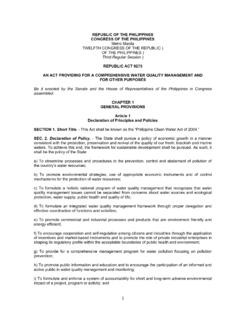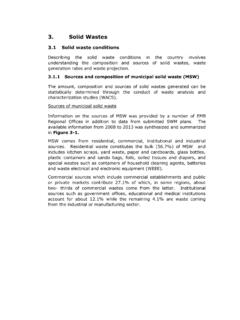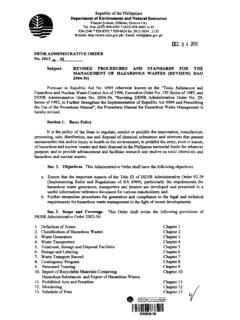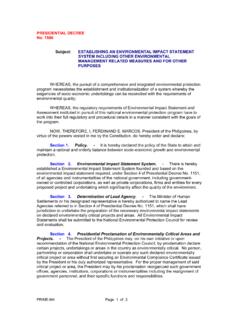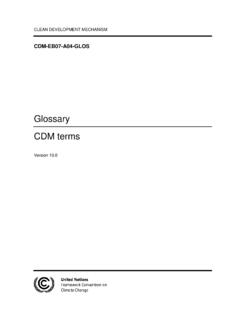Transcription of Subject: AN ACT PROVIDING FOR A COMPREHENSIVE AIR
1 PRIME - M4 Page 1 of 29S. No. 1255H. No. 6216 Republic of the PhilippinesCongress of the PhilippinesMetro ManilaEleventh CongressFirst Regular SessionBegun and held in Metro Manila, on Monday, the twenty-seventh day of July, nineteen hundred andninety ACTNo. 8749 Subject: AN ACT PROVIDING FOR A COMPREHENSIVE AIRPOLLUTION CONTROL POLICY AND FOR OTHERPURPOSESBe it enacted by the Senate and House of Representatives of the Philippines in Congressassembled:Chapter 1 General ProvisionsArticle 1 Basic Air Quality PoliciesSection 1. Short Title - This Act shall be known as the "Philippine clean Air Actof 1999."Section 2. Declaration of Principles. - The State shall protect and advancethe right of the people to a balanced and healthful ecology in accord with the rhythm andharmony of State shall promote and protect the global environment to attain sustainabledevelopment while recognizing the primary responsibility of local government units to dealwith environmental State recognizes that the responsibility of cleaning the habitat and environmentis primarily State also recognizes the principle that "polluters must pay".
2 Finally, the State recognizes that a clean and healthy environment is for the good ofall and should therefore be the concern of - M4 Page 2 of 29 Section 3. Declaration of Policies. - The State shall pursue a policy ofbalancing development and environmental protection. To achieve this end, the framework forsustainable development shall be pursued. It shall be the policy of the State to:a) Formulate a holistic national program of air pollution management that shall beimplemented by the government through proper delegation and effectivecoordination of functions and activities;b) Encourage cooperation and self-regulation among citizens and industries thoughthe application of market-based instruments;c) Focus primarily on pollution prevention rather than on control and provide for acomprehensive management program for air pollution;d) Promote public information and education to encourage the participation of aninformed and active public in air quality planning and monitoring; ande) Formulate and enforce a system of accountability for short and long-term adverseenvironmental impact of a project, program or activity.
3 This shall include thesetting up of a funding or guarantee mechanism for clean -up and environmentalrehabilitation and compensation for personal 4. Recognition of Rights. - Pursuant to the above-declaredprinciples, the following rights of citizens are hereby sought to be recognized and the Stateshall seek to guarantee their enjoyment:a) The right to breathe clean air;b) The right to utilize and enjoy all natural resources according to theprinciple of sustainable development ;c) The right to participate in the formulation, planning, implementation andmonitoring of environmental policies and programs and in the decision-making process;d) The right to participate in the decision-making process concerningdevelopment policies, plans and programs projects or activities that mayhave adverse impact on the environment and public health;e) The right to be informed of the nature and extent of the potential hazard ofany activity, undertaking or project and to be served timely notice of anysignificant rise in the level of pollution and the accidental or deliberaterelease into the atmosphere of harmful or hazardous substances;f) The right of access to public records which a citizen may need to exercisehis or her rights effectively under this Act;g) The right to bring action in court or quasi- judicial bodies to enjoin allactivities in violation of environmental laws and regulations, to compel therehabilitation and cleanup of affected area, and to seek the imposition ofpenal sanctions against violators of environmental laws.
4 Andh) The right to bring action in court for compensation of personal damagesresulting from the adverse environmental and public health impact of aproject or - M4 Page 3 of 29 Article 2 Definition Of TermsSection 5. Definitions - As used in this Act:a) "Air pollutant" means any matter found in the atmosphere other than oxygen,nitrogen, water vapor, carbon dioxide, and the inert gases in their natural ornormal concentrations, that is detrimental to health or the environment, whichincludes but not limited to smoke, dust, soot, cinders, fly ash, solid particles ofany kind, gases, fumes, chemical mists, steam and radio-active substances;b) "Air pollution" means any alteration of the physical, chemical and biologicalproperties of the atmospheric air, or any discharge thereto of any liquid, gaseousor solid substances that will or is likely to create or to render the air resources ofthe country harmful, detrimental, or injurious to public health, safety or welfare orwhich will adversely affect their utilization for domestic, commercial, industrial,agricultural, recreational, or other legitimate purposes.
5 C) "Ambient air quality guideline values" mean the concentration of air overspecified periods classified as short-term and long-term which are intended toserve as goals or objectives for the protection of health and/or public values shall be used for air quality management purposes such asdetermining time trends, evaluating stages of deterioration or enhancement of theair quality, and in general, used as basis for taking positive action in preventing,controlling, or abating air pollution;d) "Ambient air quality" means the general amount of pollution present in a broadarea; and refers to the atmosphere's average purity as distinguished fromdischarge measurements taken at the source of pollution;e) "Certificate of Conformity" means a certificate issued by the Department ofEnvironment and Natural Resources to a vehicle manufacturer/assembler orimporter certifying that a particular new vehicle or vehicle type meets therequirements provided under this Act and its rules and regulations;f) "Department" means the Department of Environment and Natural Resources;g) "Eco-profile" means the geographical-based instrument for planners anddecision-makers which present an evaluation of the environmental quality andcarrying capacity of an area.
6 It is the result of the integration of primary andsecondary data and information on natural resources and anthropogenic activitieson the land which are evaluated by various environmental risk assessment andforecasting methodologies that enable the Department to anticipate the type ofdevelopment control necessary in the planning area;h) "Emission" means any air contaminant, pollutant, gas stream or unwantedsound from a known source which is passed into the atmosphere;i) "Greenhouse gases" mean those gases that can potentially or can reasonablybe expected to induce global warming, which include carbon dioxide, methane,oxides of nitrogen, chorofluorocarbons, and the like;PRIME - M4 Page 4 of 29j) "Hazardous substances" mean those substances which present either: (1)short-term acute hazards such as acute toxicity by ingestion, inhalation, or skinabsorption, corrosivity or other skin or eye contact hazard or the risk of fireexplosion; or (2) long-term toxicity upon repeated exposure, carcinogenicity(which in some cases result in acute exposure but with a long latent period),resistance to detoxification process such as biodegradation, the potential topollute underground or surface waters;k) "Infectious waste" means that portion of medical waste that could transmit aninfectious disease;l) "Medical waste" means the materials generated as a result of patient diagnosis,treatment, or immunization of human beings or animals.
7 M) "Mobile source" means any vehicle propelled by or through combustion ofcarbon-based or other fuel, constructed and operated principally for theconveyance of persons or the transportation of property or goods;n) "Motor vehicle" mean any vehicle propelled by a gasoline or diesel engine or byany other than human or animal power, constructed and operated principally forthe conveyance of persons or the transportation of property or goods in a publichighway or street open to public use;o) "Municipal waste" means the waste materials generated from communitieswithin a specific locality;p) "New vehicle" means a vehicle constructed entirely from new parts that hasnever been sold or registered with the DOTC or with the appropriate agency orauthority, and operated on the highways of the Philippines, any foreign state orcountry;q) "Octane Rating or the Anti-Knock Index (AKI)" means the rating of the anti-knock characteristics of a grade or type of automotive gasoline as determined bydividing by two (2) the sum of the Research Octane Number (RON), plus theMotor Octane Number (MON); the octane requirement, with respect toautomotive gasoline for use in a motor vehicle or a class thereof, whetherimported, manufactured, or assembled by a manufacturer, shall refer to theminimum octane rating of such automotive gasoline which such manufacturerrecommends for the efficient operation of such motor vehicle, or a substantialportion of such class, without knocking.
8 R) "Ozone Depleting Substances (ODS)" mean those substances that significantlydeplete or otherwise modify the ozone layer in a manner that is likely to result inadverse effects on human health and the environment such as, but not limited to,chlorofluorocarbons, halons, and the like;s) "Persistent Organic Pollutants (POPs)" mean the organic compounds thatpersist in the environment, bioaccumulate through the food web, and pose a riskof causing adverse effects to human health and the environment. Thesecompounds resist photolytic, chemical and biological degradation, which shallinclude but not be limited to dioxin, furan, Polychlorinated Biphenyls (PCBs),organochlorine pesticides, such as aldrin, dieldrin, DDT, hexachlorobenzene,lindane, toxaphere and chlordane;PRIME - M4 Page 5 of 29t) "Poisonous and toxic fumes" mean any emissions and fumes which arebeyond internationally-accepted standards, including but not limited to WorldHealth Organization (WHO) guideline values;u) "Pollution control device" means any device or apparatus used to prevent,control or abate the pollution of air caused by emissions from identified pollutionsources at levels within the air pollution control standard established by theDepartment.
9 V) "Pollution control technology" means the pollution control devices, productionprocesses, fuel combustion processes or other means that effectively prevent orreduce emissions or effluent;w) "Standard of performance" means a standard for emissions of air pollutantwhich reflects the degree of emission limitation achievable through theapplication of the best system of emission reduction, taking into account the costof achieving such reduction and any non-air quality health and environmentalimpact and energy requirement which the Department determines, andadequately demonstrates; andx) "Stationary source" means any building or immobile structure, facility orinstallation which emits or may emit any air 2 Air Quality Management SystemArticle 1 General ProvisionsSection 6. Air Quality Monitoring and Information Network. - The Departmentshall prepare an annual National Air Quality Status Report which shall be used as the basisin formulating the Integrated Air Quality Improvement Framework, as provided for in Section7.
10 The said report shall include, but shall not be limited to the following:a) Extent of pollution in the country, per type of pollutant and per type of source, based onreports of the Department's monitoring stations;b) Analysis and evaluation of the current state, trends and projections of air pollution at thevarious levels provided herein;c) Identification of critical areas, activities, or projects which will need closer monitoring orregulation;d) Recommendations for necessary executive and legislative action; ande) Other pertinent qualitative and quantitative information concerning the extent of airpollution and the air quality performance rating of industries in the Department, in cooperation with the National Statistical Coordination Board(NSCB), shall design and develop an information network for data storage, retrieval - M4 Page 6 of 29 The Department shall serve as the central depository of all data and informationrelated to air 7.
